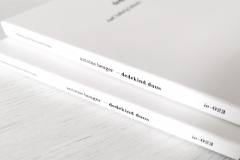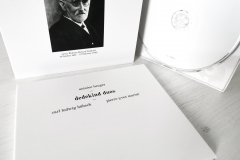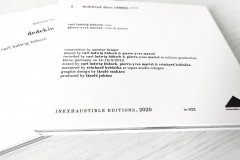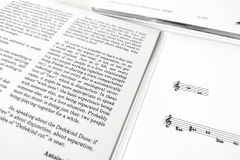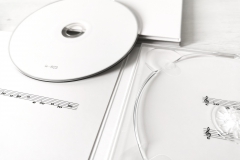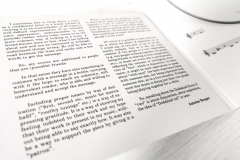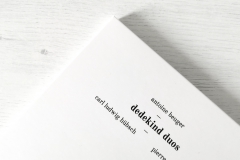Antoine Beuger – Dedekind Duos
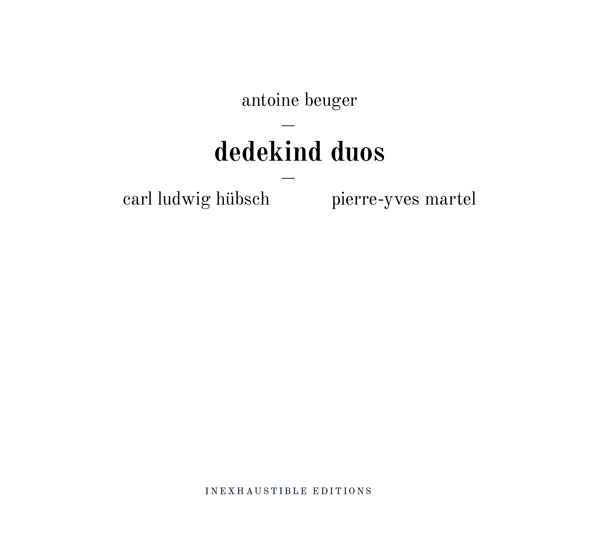
1. Dedekind Duos (2003) (49:33)
· Carl Ludwig Hübsch: tuba
· Pierre-Yves Martel: viola da gamba
Composition by Antoine Beuger
Played by Carl Ludwig Hübsch & Pierre-Yves Martel
Recorded by Carl Ludwig Hübsch & Pierre-Yves Martel at Schloss Gnadenthal, Kleve, Germany on 14-15/3/2019
Mixed by Carl Ludwig Hübsch, Pierre-Yves Martel & Reinhard Kobialka
Mastered by Reinhard Kobialka at Topaz Studio Cologne
Graphic design by László Szakács
Produced by László Juhász
I sometimes like to think about a score as a confidential letter to a friend instead of viewing it as an unmistakable, in all respects well-defined representation of an intended sonic appearance, understandable to any possible reader, which today seems to be the more common way of looking at a score. A friend knows more or less, what I am talking about and will not be interested to willingly understand things wrong. He will be able to read between the lines and needs only a few words to get the message.
So, my scores are addressed to people that are (possible) friends.
In that sense they have also something in common with a message in a bottle, carrying with it the hope to reach an unknown, still benevolent reader, who is able and willing to understand and accept the message.
Including proper names by way of dedication (“first, second etc. music for marcia hafif”, “routley tunings” etc.) is a way of expressing gratitude. It is a way of showing my feeling indebted to their work and my hope that their work is present in my music, without being able to say exactly how. It may also be a way to support the piece by giving it a “patron”.
When I write for duo situations, I want to learn about what is specific for “two” as opposed to “one” or “three”. In other words: writing a duo, I want to learn about separation, not about sharing; about love, not about friendship etc. On the other hand, if I want to find something revealed about sharing, why should I write a duo?
Of course it is possible to have a duo music in which the aspect of separation, or, as I would say, of two-ness, is not or not primarily realized. Just as in life, not every relation of two people is a love relationship (e.g. two people working together, two people being friends or sharing a train compartment etc.), in music not every duo is automatically reflecting the intrinsic or ontological structure of “two”, which is disjunction. In these cases, it might be more appropriate to speak about “with-ness”, the basic experience being with someone else, not being separated from someone else, as in a love situation. Probably most duo music is doing just that: two people being/playing together for a while.
So, speaking about the Dedekind Duos: if “two” is about disjunction, about separation, the idea of “Dedekind cut” is near.
Antoine Beuger
Released: June 2020 / first edition of 300 cds
Direct purchase: Bandcamp / Discogs
GALLERY ↓
REVIEWS ↓
“Despite the extreme formal essentiality – or precisely because of it – the musical aesthetics of Antoine Beuger is one of the hardest to grasp among those of the Wandelweiser collective, the singular international community of which he is the main founder. Over time his scores have been inspired by important figures in every area of knowledge, from philosophy to cinematography, from poetry to music itself: a variety of suggestions that unfailingly translates into an extreme tonal and expressive reductionism; a natural disposition that leads to consider Beuger as a sort of ‘de-composer’ intent on dissecting, cataloging and preserving the minimum terms of each intuition he relies on, time after time.
In 2003 the Dutch author dedicated two works to important figures in mathematical studies, namely Georg Cantor (1845-1918) and Richard Dedekind (1831-1916), who knew each other well and had a long-lasting correspondence. To the latter we owe significant contributions in the theory of numbers, and above all the definition of infinite sets as a fundamental concept for understanding the world. Beuger therefore tributes him the Dedekind Duos (2003), which can be performed with any two instruments. Dating back to 2009, the first recording was published by the same Edition Wandelweiser and played by the duo Contour (vibraphone and trumpet), the formation for which the piece was originally written. Now it’s the Slovenian Inexhaustible Editions that releases a new interpretation for tuba and viola da gamba by Carl Ludwig Hübsch (Ariha Brass Quartet, among other countless ensembles) and Pierre-Yves Martel (recently heard alongside Matthias Müller in Dis-Drill).
In an interview with Simon Reynell, director of Another Timbre, Beuger explains that, for him, duo music is ‘music about being two, or, more radically, about love. […] The art of approximation (in tuning, timing, sound balancing…), can be the most reminiscent, commemorative, resonant of the single most important event, that human beings may experience in their lives: love’. Therefore, if we also look at the Dedekind Duos in this perspective, we realize that in the dialogue between the brass and the string instrument the marked and the caressing stroke, the unison and the alternation constantly give way to each other, and the discontinuous intersection of sustained tones generates sometimes placid harmonies, sometimes grotesque dissonances. As is true of post-Feldmanian poetics, the performers do not seek the perfection of the sound gesture, and rather welcome the flexes and cracks of the individual notes as if they were the reflection of human fragility, of the secret beauty that lies in fallibility.
Hübsch and Martel’s subdued interplay is aimed exclusively at the ‘corporeity’ of sound in relation to time, the imperfect completeness of each discrete element within a flow of signs without intrinsic meaning, but from which luminous, overarching vision arises: a potentially infinite, albeit imaginary, horizon line.” / Michele Palozzo, Esoteros, 21 June 2020
“As I am listening to this Antoine Beuger composition, performed by Carl Ludwig Hübsch on tuba and Pierre-Yves Martel on viola da gamba, I have the balcony doors open and sounds from outside mingle with the music. The music is very slow-paced with the two musicians playing their notes solemnly and with considerable pacing of silences in between. It is here where the music mingles with the sounds in my area; a car passing, an owl, people talking; none of those sounds are continuous and just like the music, they drift in and out. The title is a reference to [quote Wiki:] ‘Julius Wilhelm Richard Dedekind (6 October 1831–12 February 1916) was a German mathematician who made important contributions to abstract algebra (particularly ring theory), the axiomatic foundation for the natural numbers, algebraic number theory and the definition of the real numbers.’ As I am no mathematician, I could say if there is some repeating pattern (or even more) within the music. That sort of analytical approach is not how I listen to music. I am more the sort of person to sit back, listen, take it in, and consider various possibilities; do I enjoy this, and why (or not, of course)?, is it new, or confrontational, difficult, minimal etc. and why is it that I like this. The slow and repeating patterns played here have quite a calming effect on me, especially with those changing ‘extra’ sounds from outside; I can imagine some of this will be easily lost if you live in a noisy environment and it will be more difficult to enjoy the music. This is something to play at a moderate volume and, if you wish, do some meditation. Doing nothing worked also pretty well. Great CD.” / Frans de Waard, Vital Weekly, 1 September 2020
“Three excellent, recent-ish releases from Inexhaustible Editions made there way to my abode last week. Annette Krebs / Jean-Luc Guionnet – Point Sèche. A spacious, imaginative duo from 2018 with Krebs at her Konstruktion #4 (an amalgamation of various items) and Guionnet on church organ. The latter used in extreme fashion, but not loudly or garishly, rather with subtle, smoky attenuations weaving among the welter of sounds generated by Krebs, very enveloping – some of my favorite work from either musicians in a while. Gerard Lebik / Noid – Psephite. A wide-ranging 2013 date with Lebik on sound objects and Noid on cello. Either player moving through steady-state forms, traditional playing and rambunctious, sharp-angled work. Disorienting and absorbing; good work, always surprising. Antoine Beuger – Dedekind Duos. Performed by Carl Ludwig Hübsch (on tuba) and Pierre-Yves Martel (on viola da gamba). A fuller-sounding piece than much of Antoine’s work, this pair also takes things more aggressively than typically heard in a Wandelweiser performance, the tuba robust and deep, the viola da gamba forthrightly grainy and richly complex. Interesting to hear this approach and I find the result intriguing and often exciting. All three well worth hearing.” / Brian Olewnick, Facebook, 5 September 2020
“Le label Inexhaustible Editions s’affirme comme une plate-forme incontournable et pointue en matière de musiques improvisées et « composées – alternatives » contemporaines (comme Confront, Another Timbre, Potlatch, Creative Sources, etc…). Leurs pochettes monochromes blanches avec caractères d’imprimerie noirs recèlent des compositeurs travaillant à la frange de l’improvisation. Antoine Beuger a écrit les Dedekind Duos (2003), en se référant à Julius Wilhelm Richard Dedekind (6-10-1831 – 12-02-1916), tout en adressant cette composition à des musiciens (de préférence) amis, car dit-il, ils doivent le connaître personnellement pour interpréter sa musique. Ici, le tandem Carl Ludwig Hübsch (tuba) et Pierre-Yves Martel (viole de gambe) joue ces Dedekind Duos dont le compositeur dissèque certains tenants et aboutissants dans des notes de pochette éclairantes. À l’écoute, on entend les artistes très concentrés soutenir des notes tenues assez brèves dont la résonnance/ réverbération s’échappe dans le silence et dont l’architecture linéaire – où le sens de la perspective est infime – est constamment modifiée avec une lente et précise application, paramètre par paramètre… dans des détails pas toujours immédiatement perceptibles. Il faut écouter avec la même attention que pour un album de musique plus complexe et plus « fourni ». Les deux artistes développent la musique durant 49 minutes 33 secondes. C’est en soi une véritable performance. Ce travail est aussi à la base du travail instrumental le plus basique auquel ils confèrent une profonde dimension esthétique. Il faut entendre la vibration de chaque corde frottée par Pierre-Yves Martel évoluer dans des registres de timbres très différents sans jamais fausser le caractère fondamental de la composition. Son compagnon choisit l’intonation dans son embouchure en symbiose avec celle de la viole de gambe, instrument roi de la musique d’une autre temps, celui du Roi Soleil, autre fois souverain du Canada, pays d’origine du cordiste.
À ceux qui parmi les afficionados de l’improvisation qu’on qualifierait de plus « conventionnelle », car moins minimaliste, et qui récuse cette forme de « minimalisme », je peux témoigner, en tant que chanteur vocaliste, que l’implication totale de ces deux artistes est l’évidence même. En effet, selon mon expérience de vocaliste autodidacte n’ayant jamais suivi aucun cours (!) et dont le talent est reconnu par des « pointures légendaires », la base même du chant organique est de pouvoir tenir UNE SEULE NOTE dans un temps précis (avec crescendo , haha !) sans la moindre déviation (vers le haut ou le bas) et changement de timbre avec une certaine majesté et que cela demande autant de concentration, de technique et d’effort que de « jouer », chanter et se laisser aller à improviser librement, à parcourir les gammes en piochant dans leur ordonnancement. De là à ce que des musiciens fassent de cette pratique l’objet d’une œuvre est donc bien légitime. Ici les micro-sections évoluent pour le plaisir de nos oreilles, il faut de la patience pour s’en apercevoir. Et la patience est le maître mot des musiciens itinérants face aux aléas de la scène et de la vie. Un très bon point.
Cela dit, la question de « l’amitié » requise par Beuger (dans son texte) pour improviser valablement en duo est, à mon avis, contredite par les circonstances effectives de la vie des improvisateurs. J’ai dû moi-même improviser sur scène avec des musiciens que je n’avais jamais rencontré auparavant et l’expérience fut concluante, enregistrements à l’appui. C’est d’ailleurs à cela que de nombreux improvisateurs sont forcés s’ils veulent sortir de leur trou et évoluer positivement. Je viens encore de produire un chef d’œuvre de deux musiciens qui ne se connaissaient pas auparavant et ont enregistré leur premier duo sans avoir même pu essayer cette formule avant la session proprement dite. Une fois ce premier pas franchi, c’est un véritable esprit amical qui naît, indispensable à une entente créative ultérieure. Le mystère de la musique.” / Jean-Michel Van Schouwburg, Orynx-improv’andsounds, 11 November 2020
“Dedekind Duos is played by Carl Ludwig Hübsch and Pierre-Yves Martel, both fellows associated with free improvisation, but this single 49:33 piece is in fact a composition written by Antoine Beuger. We last heard this Wandelweiser person on To The Memory Of, released in 2017 on this same label, and with a very similar cover design of bare-bones typography. Hübsch plays the tuba, Martel plays the viola de gamba (one of the few musicians in this genre who does, I’ll wager), and the composition creeps along in a low-key, slow-moving mode, with long tones and tense silences to further the listener’s contemplation. It’s a flawless performance, each immaculate minimal note played with precision and care and landing in just the right place; less disjunctive than other Wandelweiser pieces I may have heard, this one gradually coalesces into strings of coherent sentences, and an essay (if not an entire book) emerges in musical form.
A photo of Julius Wilhelm Richard Dedekind appears on one panel of the six-panel digipak; he was an historic person, a German mathematician of the 19th century who made important discoveries that paved the way for definition of ‘real numbers’, a concept which I would expect is beyond me as I can barely manage to count up to ten on my own fingers and toes. If there is a numerological concept underpinning Dedekind Duos, it may have something to do with what Beuger calls ‘the intrinsic or ontological structure of ‘two’, which is disjunction’. However, I’m taking his words out of context. In his mini-essay, he muses about his work of composition, and confesses that he doesn’t regard his scores as finished, ideal pieces which could be read and performed by any musician; rather, he describes a score as ‘a confidential letter to a friend’. This doesn’t mean that he only elects to work with sympathetic musicians, but it does imply that he’s hoping his message will fall on sympathetic ears. I like this idea, which on one level represents a departure from the norms of classical music, especially with regard to sheet music, printed scores with their representations of dynamics, metre, and so forth; they are examples, perhaps, of a very coded way of working which our culture has been conditioned to accept as a normal representation of musical language. On another level, Beuger is admitting that his music is not for everyone, and (like many artists before him have discovered), creating art is like sending a message in a bottle. Of the four CDs, this one will satisfy your philosophic leanings and provide intellectual fodder to the brain.” / Ed Pinsent, The Sound Projector, 2 March 2021
RADIO PLAYS ↓
· No Wave at Tilos Rádió, Budapest, 11 September 2020

